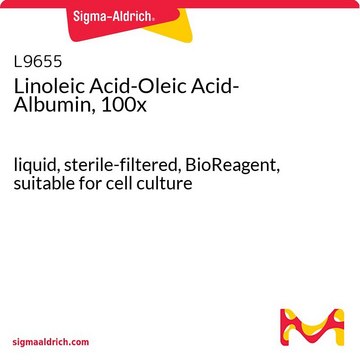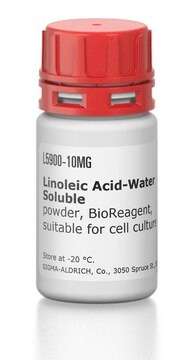L5900
Linoleic Acid-Water Soluble
powder, BioReagent, suitable for cell culture
About This Item
Recommended Products
biological source
plant (Safflower oil)
Quality Level
product line
BioReagent
form
powder
technique(s)
cell culture | mammalian: suitable
solubility
H2O: 50 mg/mL
storage temp.
−20°C
1 of 4
This Item | O1257 | L1012 | L8134 |
|---|---|---|---|
| technique(s) cell culture | mammalian: suitable | technique(s) cell culture | mammalian: suitable | technique(s) cell culture | mammalian: suitable | technique(s) activity assay: suitable |
| form powder | form powder | form liquid | form powder |
| storage temp. −20°C | storage temp. −20°C | storage temp. −20°C | storage temp. −20°C |
| solubility H2O: 50 mg/mL | solubility H2O: 50 mg/mL, clear to slightly hazy | solubility NaOH: 1 M, ethanol: soluble | solubility methanol: 50 mg/mL, clear, yellow |
| Quality Level 200 | Quality Level 200 | Quality Level 200 | Quality Level - |
Application
Biochem/physiol Actions
Other Notes
Package size based on linoleic acid content.
related product
Signal Word
Warning
Hazard Statements
Precautionary Statements
Hazard Classifications
Eye Irrit. 2
Storage Class Code
11 - Combustible Solids
WGK
WGK 3
Flash Point(F)
Not applicable
Flash Point(C)
Not applicable
Certificates of Analysis (COA)
Search for Certificates of Analysis (COA) by entering the products Lot/Batch Number. Lot and Batch Numbers can be found on a product’s label following the words ‘Lot’ or ‘Batch’.
Need A Sample COA?
This is a sample Certificate of Analysis (COA) and may not represent a recently manufactured lot of this specific product.
Already Own This Product?
Find documentation for the products that you have recently purchased in the Document Library.
Customers Also Viewed
Articles
Importance and uses of linoleic acid in serum-free eukaryotic, including hybridoma and Chinese Hamster Ovary (CHO) cell, cultures
How the unsaturated fatty acid, oleic acid and other cell culture components affect the performance of serum-free, protein-free cell culture systems used for biomanufacturing heterologous proteins including monoclonal antibodies.
Our team of scientists has experience in all areas of research including Life Science, Material Science, Chemical Synthesis, Chromatography, Analytical and many others.
Contact Technical Service







